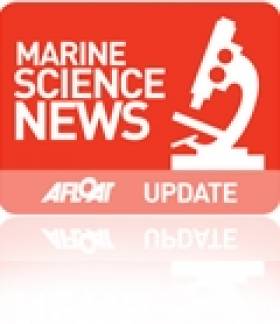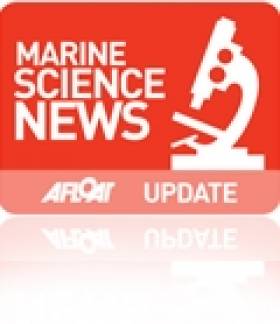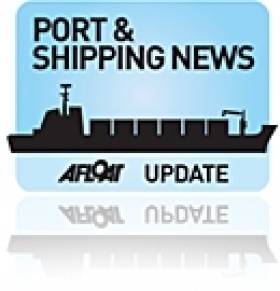Displaying items by tag: Marine Science News
INFOMAR Maps Out Proposed Operations for 2013
#INFOMAR – The Integrated Mapping for the Sustainable Development of Ireland's Marine Resource, in short (INFOMAR) have outlined their proposed mapping operations for 2013.
INFOMAR (covering 125,000 sq kms) is a joint venture between the Geological Survey of Ireland (GSI) and the Marine Institute.
During the current year of INFOMAR Phase 1 (2006-2016), operations are provisionally planned to take place within tabulated bays subject to approval from other agencies.
To see a map of proposed working area and more, Inshore Ireland (February / March) issue has a report.
As previously reported on Afloat.ie, the GSI's survey vessel RV Keary last month returned to service, having completed modifications carried out at Arklow Marine Services. The 15m aluminium catamaran research vessel was built in South Africa and is equipped with a full geographical suite.
Scientific ‘Explorer’ Makes a Fleeting Call to Dublin Port
#IrishSeaSurvey – The Marine Institute's Galway based RV Celtic Explorer made a brief call yesterday to Dublin Port, while in between carrying out separate scientific surveys, writes Jehan Ashmore.
The 65m vessel, which is not a regular visitor to the port, had berthed at Ocean Pier. According to the Marine Institute's vessel survey schedule, she was conducting a Methane-derived Authigenic Carbonate (MDAC) survey headed by chief scientist Dr. Yvonne Leahy of the institute.
The survey was to complete a drop camera survey of a MDAC site in the Irish Sea, some 25 nautical miles offshore of Dublin Bay.
Celtic Explorer which is 2,425 tonnes and has a total of 35 personnel, and equally the same number of days in endurance range. Accommodation is for 22-30 scientists, 13-15 crew (dependent to operational requirements). Scientific quarters are for 4 single cabins and 9 double en-suite cabins.
Her inshore fleetmate, the 31m RV Celtic Voyager of 340 tonnes has an endurance capability of 14 days. A total of 15 personel made up of 8 scientists and 7 crew are accommodated in 4-berth quarters.
Research Vessel Speeds Home following Modification Work
#ResearchVessel – The Geological Survey of Ireland (GSI) research vessel Keary, returned to her homeport of Dun Laoghaire Harbour today, having completed modifications at Arklow Marine Services, writes Jehan Ashmore.
The South African built aluminium catamaran craft had been hoisted onto the quayside at the Co. Wicklow port so to allow the work to begin.
She made her homebound journey with a high-speed transit through Dalkey Sound, and completed her voyage to the 820-berth Dun Laoghaire marina.
As previously reported on Afloat.ie the RV Keary was joined in October by the former Inland Fisheries Ireland cutter, Cosantóir Bradán. She is employed as part of INFOMAR, the national marine mapping programme, conducted by the GSI and Marine Institute.
Research Vessels Call to Dublin Bay Ports
#SCIENCE SHIPS – It is a rare to have both Marine Institute research vessels calling at the same time to east-coast ports, as normally these Galway-based ships managed by P&O Maritime Services, work off the rest of the Irish coast, writes Jehan Ashmore.
As previously reported on Aflaot.ie, the RV Celtic Explorer docked in Dublin Port earlier this week. The 65.5m long vessel currently remains moored alongside Sir John Rogersons Quay (berth 6) as the 10-day Euroscience Open Forum 2012 (ESOF) concludes tomorrow in the Convention Centre. High-level delegates from the international scientific community have made the short crossing over the Liffey's Samuel Beckett Bridge to be welcomed on board.
Across Dublin Bay the RV Celtic Voyager had called to Dun Laoghaire Harbour yesterday, where she stayed overnight for a mid-scientific cruise break, while berthed at St. Michaels Wharf. The 31.4m vessel this morning resumed her scheduled Infomar 2 hydrographic work in the Irish Sea.
#MARINE RESEARCH YACHT– The 36m French marine biology research yacht Tara, skippered by Loic Valette, sailed under motor-power into Dun Laoghaire Harbour from Lorient this afternoon, writes Jehan Ashmore.
The two-master is operated by Tara Expeditions which is a non-profit organisation which aims to learn more about the impact of climate change on ecosystems. She has travelled extensively on expeditions to both poles and throughout the world and where the organsiation have collected samples and data to the scientific community.
The port of call is so that she can take part in the Dublin 'City of Science 2012' festival.
Tara will be moored alongside the harbour's East Pier during tomorrow and Thursday, where the public are invited on board to tour the vessel on a first come first served basis. Opening times on both days are between 1-7pm and taken in small groups, noting limited accessibility. Crew will provide guided tours of the class B aluminium built yacht once owned by Jean-Louis Etienne and Sir Peter Blake. For further details click HERE.
As previously reported, the Marine Institute's RV Celtic Explorer docked in Dublin Port today in advance of the ESOF 2012 conference which is the highlight of the year-long science festival. For information visit www.dublinscience2012.ie
RV Celtic Explorer to Visit ESOF 2012
#ESOF IN DUBLIN - The Euroscience Open Forum 2012 (ESOF) is to take place in the Convention Centre in Dublin from tomorrow until next Sunday. As part of the key conference, the Marine Institute's RV Celtic Explorer which docked in the centre of the port today, is expected to relocate berths later in the week for visiting high-level delegates, writes Jehan Ashmore.
The forum is billed as Europe's largest general science conference and the capital was chosen to host the Dublin 'City of Science 2012' festival which is year-long celebration of science. The prestigious international event features over 160 events that will showcase the best of Irish culture, arts and science.
Added to this is a 'Science in the City' festival (6-15th July) which is currently well-under way, for further information visit www.dublinscience2012.ie
#MARINE SCIENCE – The Marine Institute has a research vessel training position under its Stagiaire Programme, which is designed to enable recent graduates to gain work experience in an area in which they are interested.
As part of Ocean Science and Information Services, you will provide administrative support to the work activities of the Team Leader and to the Operations and Director of OSIS in the management and delivery of Research Vessel (RV) Operations Office services.
This Stagiaire position is an excellent training opportunity for a recent graduate of business, administration or a related subject. The fixed term, fixed purpose Graduate Training contract will run for a maximum of 50 weeks. The successful candidate will be on probation for the first 6 months of this training contract. For further information and how to apply, click HERE.
French Scientific Schooner to Visit Dun Laoghaire Harbour
#MARINE SCIENCE TALLSHIP- As part of Dublin City of Science 2012, a 'Science in the City' festival (6-15 July) is to include the French scientific expedition schooner Tara, which is to receive a welcoming flotilla on her arrival to Dun Laoghaire Harbour on 10th July, writes Jehan Ashmore.
At only 36m long, the Tara is unique vessel in that she is used for scientific discovery and adventure purposes, as otherwise most such vessels are larger motorships. The schooner is run by the French based non-profit organisation Tara Expeditions that provides samples and data to the scientific community worldwide.
She has accomplished eight expeditions – to the Antarctica, Arctic, Greenland, Patagonia, southern Georgia and throughout the rest of the world. Before her scientific adventure role she was owned by Jean-Louis Etienne and Sir Peter Blake.
Tara Expeditions aim to learn more about the impact of climate change on ecosystems. One of the core objectives is to increase environmental awareness among the general public, and particularly young people through their Tara Junior outreach programme.
She is to be open to the public at her mooring at the harbour's East Pier where her crew will provide guided tours on the 11th and 12th June. Visits on a first come first served basis (between 11am-6pm) where 3 to 4 groups numbering between 8-12 people will be accommodated.
GSI Charter Central Fisheries Cutter
#RESEARCH VESSEL CHARTER - The Geological Survey of Ireland (GSI) have chartered the Cosantoir Bradan from the Central Fisheries Board
The fisheries patrol cutter is to be used in conjunction with the RV Keary for survey work, including bottom survey of all coastal regions around Ireland.
The 15m catamaran inshore research vessel is currently undergoing modifications and refurbishing works at Arklow Marine Services yard.
Mainport to Invest in Survey Supply Vessels for Exploration Industry
#PORTS & SHIPPING - Cork based marine services company, Mainport is investing $36 million (€27.6 million) to build three supply vessels which will support seismic survey ships searching for oil and gas deposits.
The bulk of the financing for the construction of the newbuildings has been provided by Dutch bank ABN Amro, with a syndicate of Irish investors assembled by Westboro Finance in Cork providing $5 million in mezzanine, or short-term, financing.
The three ships, which will provide support services for an unnamed client carrying out off-shore seismic surveys around the world, are being constructed at Shin Yang Shipyards in Malaysia, and will be delivered in mid-2013.
To read more about this report in today's Irish Times click HERE







































































